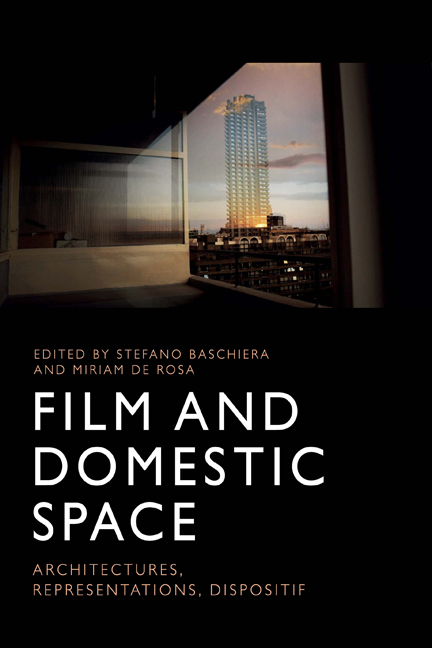Book contents
- Frontmatter
- Contents
- List of Figures
- Notes on the Contributors
- Acknowledgements
- Introduction
- 1 Architectures of Ubiquity: The Colonial Revival in Film and Television
- 2 No Down Payment: Whiteness, Japanese American Masculinity and Architectural Space in the Cinematic Suburbs
- 3 Resist, Redefine, Appropriate: Negotiating the Domestic Space in Contemporary Female Biopics
- 4 Liminal Spaces, Lesbian Desire and Veering off Course in Todd Haynes’s Carol
- 5 A Home on the Road in Claire Denis’s Vendredi soir
- 6 Acoustic Ectoplasm and the Loss of Home
- 7 Our House Now: Flat and Reversible Home Spaces in Post-war Film and Television
- 8 From Myth to Reality: Images of Domestic Space in Post-Soviet Baltic Films
- 9 No | Home | Movie: Essay Film, Architecture as Framing and the Non-house
- 10 At Home with the Nouvelle Vague: Apartment Plots and Domestic Urbanism in Godard’s Une femme est une femme and Varda’s Cléo de 5 à 7
- 11 Dwelling the Open: Amos Gitai and the Home of Cinema
- 12 What Is Cult When It’s At Home? Reframing Cult Cinema in Relation to Domestic Space
- 13 High-fructose Cinema and the Movie Industrial Complex: Radicalising the Technology of Representation in a Domestic Kind of Way
- Index
Introduction
Published online by Cambridge University Press: 22 September 2020
- Frontmatter
- Contents
- List of Figures
- Notes on the Contributors
- Acknowledgements
- Introduction
- 1 Architectures of Ubiquity: The Colonial Revival in Film and Television
- 2 No Down Payment: Whiteness, Japanese American Masculinity and Architectural Space in the Cinematic Suburbs
- 3 Resist, Redefine, Appropriate: Negotiating the Domestic Space in Contemporary Female Biopics
- 4 Liminal Spaces, Lesbian Desire and Veering off Course in Todd Haynes’s Carol
- 5 A Home on the Road in Claire Denis’s Vendredi soir
- 6 Acoustic Ectoplasm and the Loss of Home
- 7 Our House Now: Flat and Reversible Home Spaces in Post-war Film and Television
- 8 From Myth to Reality: Images of Domestic Space in Post-Soviet Baltic Films
- 9 No | Home | Movie: Essay Film, Architecture as Framing and the Non-house
- 10 At Home with the Nouvelle Vague: Apartment Plots and Domestic Urbanism in Godard’s Une femme est une femme and Varda’s Cléo de 5 à 7
- 11 Dwelling the Open: Amos Gitai and the Home of Cinema
- 12 What Is Cult When It’s At Home? Reframing Cult Cinema in Relation to Domestic Space
- 13 High-fructose Cinema and the Movie Industrial Complex: Radicalising the Technology of Representation in a Domestic Kind of Way
- Index
Summary
In an essay published in 2008, Malte Hagener significantly asked the question ‘where is cinema today’? Whilst the main argument in the text inclines more towards concerns that are not entirely centred on spatiality per se, we can see, in retrospect, that this question clearly summarised what would eventually be termed the spatial turn in film studies. Such a turn represents a key move in the consideration of spatial ‘contexts’ as important to the ‘text’, as well as the experiences deriving from them. A key contribution in this sense is the volume edited by Elena Gorfinkel and John David Rhodes (2011), which very effectively reminds the reader how film not only documents reality but ‘takes place’ within it. Stressing the strong link between the site where moving images are consumed and film itself, and somewhat reminded of the earlier seminal work by Barbara Kruger (1994) in relation to home video viewing, the authors put a particular emphasis on spectatorship. Space, then, ceases to be a coordinate solely employed by film to locate the narration, and appears in its fascinating complexity as a dimension that is represented on screen but at the same time that is physical, off-screen, where the film actually unfolds. Giuliana Bruno (1993, 2002, 2007), Catherine Fowler (2008) and Alison Butler (2010), among others, have probably written the most captivating pages about the point of encounter of these two spheres. Each of these authors has analysed specific examples and focused on particular elective objects of study: film journeys coupled with itineraries in art spaces for Bruno; gallery films, their relationship with the museum space, and the impact of such relationship on representability in Fowler; the textual component characterising a number of installation works in Butler. Yet, they have a shared merit, namely to demonstrate very clearly that the job of the viewer may go well beyond her/his participation in the screening: a possibility to practice space pairs the cognitive and interpretive work classically elicited by diegesis.
Experiments from the avant-gardes and in the area of expanded cinema (see, for example, Youngblood's classic text, 1970) had already identified the convergence and interaction of diegetic and extra-diegetic space as an interesting and productive area of inquiry and creativity.
- Type
- Chapter
- Information
- Film and Domestic SpaceArchitectures, Representations, Dispositif, pp. 1 - 15Publisher: Edinburgh University PressPrint publication year: 2020



